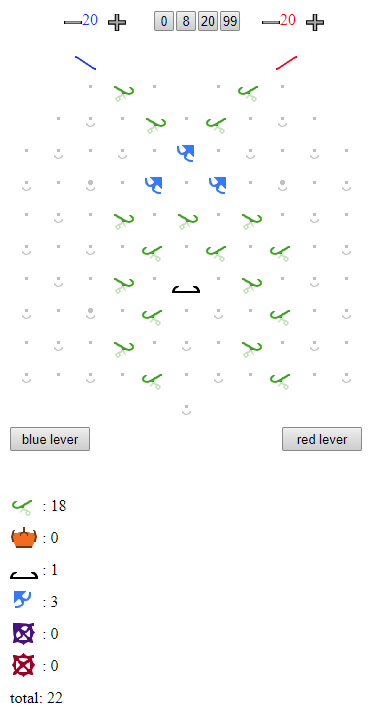I’ll start by showing some solutions with more parts that hopefully make it easier to see how I arrived at the 19 parts. All images link to the online emulator.
The first solution at 22 parts:
The machine starts with the red lever. By starting from red and inverting our logic, we know exactly which state the machine is in when we reach the third (blue) ball. That way, we can avoid a bunch of crossovers and feed that blue ball directly into the top bit, because we know it’s going to lead to the interceptor in this state.
In order to start with red, we need to implement “short circuiting”: if the B bit points left, we immediately send it to the interceptor. Otherwise, we release another red ball and check the A bit. If that points left, we go to the interceptor again, otherwise we release the blue ball which we know will reach the interceptor.
The smallest I’ve found starting with the blue lever was 23 parts. Since the bits can be in several states when we reach the final red ball, we can’t feed that ball straight into the top bit, but we need to spend another ramp to the B bit (whose state we can guarantee).
Now, here’s another 22-part solution that doesn’t use any crossovers at all:
It works basically the same, but we swap the second and third balls (something we couldn’t easily do, had we started with the blue level). That is, if the first (red) ball doesn’t get intercepted it releases a blue ball. That means when checking the second bit, we can switch things around so that the centre path (i.e. right from the left bit or left from the right bit) is always the one that leads to the interceptor. If the blue ball doesn’t got there, it releases another red ball, which we now know will reach the interceptor.
Now that we’re alternating between red and blue at the top, the first bit there actually doesn’t do anything other than a crossover. So let’s use a crossover there, which frees up the bit. We can use that bit to save one more part at the bottom:
Alright, the final stretch. To save more parts, we would need to join those paths to the bottom up earlier. But we can’t do that if they have to go around the outside of the interceptor. To fix that, we get rid of the crossover at the top, so that the red ball checks the B bit and the blue ball checks the A bit. That way, both of the paths that require another ball lead to the centre column and we can join them up immediately. That saves quite a bunch of parts, and we get down to 19 even though we need to add a part at the top and a part to separate the interceptor branches. Here’s the final result:



